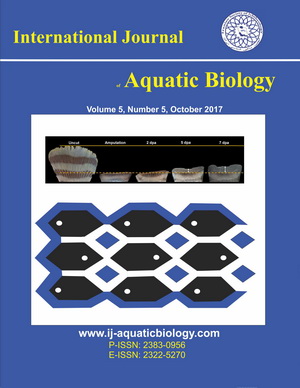Structural surface properties of perspective marine antifouling coating based on bimetallic nanoparticles in organic matrix
Downloads
The paper presents the results of a study on the potential protective anti-fouling coating obtained through the uniform distribution of bimetallic oxide nanoparticles containing copper and iron atoms within an organic matrix. The organic matrix was formed by mixing a suspension of the nanoparticles in xylene with a styrene-acrylic resin. Data on the dynamic light scattering of the initial xylene suspensions and similar suspensions stabilized by centrifugation are provided. The suspension produced an anti-fouling coating, which was investigated using atomic force microscopy and scanning electron microscopy methods. It is demonstrated that as the mass fraction of particles in the matrix increases, noticeable agglomeration occurs. Additionally, exceeding a mass concentration of 20% leads to their uneven distribution within the organic matrix. The results of testing CuO-FeCuO nanoparticles-based antifouling coating in seawater regarding its biocidal effect on heterotrophic bacteria are presented. It is shown that the coating reduces the microfouling effect by 85% compared to an unprotected similar sample.
Downloads
Atacan K. (2019). CuFe2O4/reduced graphene oxide nanocomposite decorated with gold nanoparticles as a new electrochemical sensor material for Ï-cysteine detection. Journal of Alloys and Compounds, 791: 391-401.
Bakina O.V., Glazkova E.A., Svarovskaya N.V., Rodkevich N.G., Lerner M.I. (2019). «Janus»-like Cu-Fe bimetallic nanoparticles with high antibacterial activity. Materials Letters, 242: 187-190.
Covaliu I.C., Neamtu J., Georgescu G., Malaeru T., Cristea C., Jitaru I. (2011). Synthesis and characterization of ferrites (Fe3O4/CuFe2O4)-calcium alginate hybrids for magnetic resonance imaging. Digest Journal of Nanomaterials and Biostructures, 6(1): 245.
Dahms H.U., Dobretsov S. (2017). Antifouling compounds from marine macroalgae. Marine Drugs, 15(9): 265.
Dobretsov S., Thomason J.C. (2011). The development of marine biofilms on two commercial non-biocidal coatings: A comparison between silicone and fluoropolymer technologies. Biofouling, 27(8): 869-880.
Inbakandan D., Kumar C., Abraham L., Kirubagaran R., Venkatesan R., Khan S. (2013). Silver nanoparticles with anti microfouling effect: a study against marine biofilm forming bacteria. Colloids and Surfaces B: Biointerfaces, 111: 636-643.
Lerner M.I., Pervikov A.V., Glazkova E.A., Svarovskaya N.V., Lozhkomoev A.S., Psakhie S.G. (2016). Structures of binary metallic nanoparticles produced by electrical explosion of two wires from immiscible elements. Powder Technology, 288: 371-378.
Lewis J.A. (2009). Non-silicone biocide-free antifouling solutions. In: Woodhead Publishing Series in Metals and Surface Engineering, Advances in Marine Antifouling Coatings and Technologies, 709-724.
Li Q., Yong C., Cao W., Wang X., Wang L., Zhou J., Xing X. (2018). Fabrication of charge reversible graphene oxide-based nanocomposite with multiple antibacterial modes and magnetic recyclability. Journal of Colloid and Interface Science, 511: 285-295.
Liu J.M., Lu Y.H., Xu Z.F., Wang R.X., Yan H.C., Li X. (2021). Effect of citric acid-to-nitrate ratio on combustion synthesis of CuFe2O4 for sodium-ion storage. Journal of Materials Science: Materials in Electronics, 32: 94-101.
Loxton J., MaCleod A.K., Nall C.R., McCollin T., Machado I., Simas T., Vance T., Kenny C., Want A., Mille R.G. (2017). Setting and agenda for biofouling research for marine renewable energy industry. International Journal of Marine Energy, 19: 292-303.
Macleod A., Stanley M., Day J., Cook E. (2016). Biofouling community composition across a range of environmental conditions and geographical locations suitable for floating marine renewable energy generation. Biofouling, 32(3): 261-276.
Nakanishi E.Y., Palacios J.H., Godbout S., Fournel S. (2021). Interaction between bio?lm formation, surface material and cleanability considering different materials used in pig facilities – an overview. Sustainability, 13: 5836.
Parks G.A., de Bruyn P.L. (1962). The zero point of charge of oxides. The Journal of Physical Chemistry, 66: 967-973.
Schorne-Pinto J., Cassayre L., Presmanes L., Barnabé A. (2019). Insights on the stability and cationic nonstoichiometry of CuFeO2 delafossite. Inorganic Chemistry, 58: 6431-6444.
Smirnova L.L., Anninskaya I.N. (2003). Distribution of copper compounds in the marine environment and bottom sediments of port waters. Environmental Safety of Coastal and Shelf Zones, 9: 106. (in Russian)
Svarovskaya N.V., Bakina O.V., Pervikov A.V., Rubtsov K.V., Lerner M.I. (2020). Electrical explosion of wires for manufacturing bimetallic antibacterial Ti-Ag and Fe-Ag nanoparticles. Russian Physics Journal, 62: 1580-1586.
Tarrío-Saavedra J., López-Beceiro J., Naya S., Francisco-Fernández M., Artiaga R. (2014). Simulation study for generalized logistic function in thermal data modeling. Journal of Thermal Analysis and Calorimetry, 118: 1253-1268.
Thakare P.S., Padole P.R., Bodade A.B., Chaudhari G.N. (2018). Microstructural and antifungal properties of silver substituted copper ferrite nanopowder synthesized by sol-gel method. Indo American Journal of Pharmaceutical Sciences, 5: 52-63.
Thomas K.V., Brooks S. (2010). The environmental fate and effects of antifouling paint biocides. Biofouling, 26(1): 73-88.
Zhang Y., Chen Y., Kang Z.V., Gao X., Zeng X., Liu M., Yang D.P. (2021). Waste eggshell membrane-assisted synthesis of magnetic CuFe2O4 nanomaterials with multifunctional properties (adsorptive, catalytic, antibacterial) for water remediation. Colloids and Surfaces A: Physicochemical and Engineering Aspects, 612: 125874.
Copyright (c) 2025 International Journal of Aquatic Biology

This work is licensed under a Creative Commons Attribution 4.0 International License.








